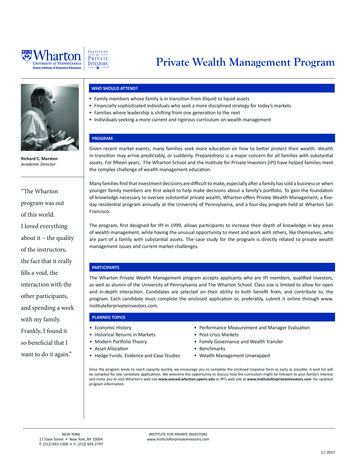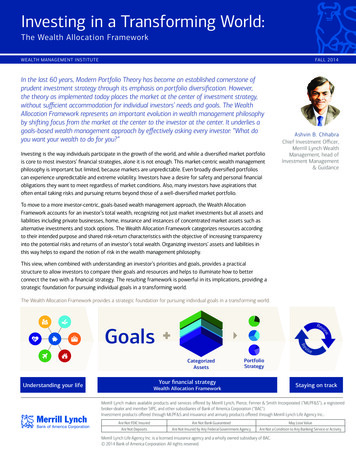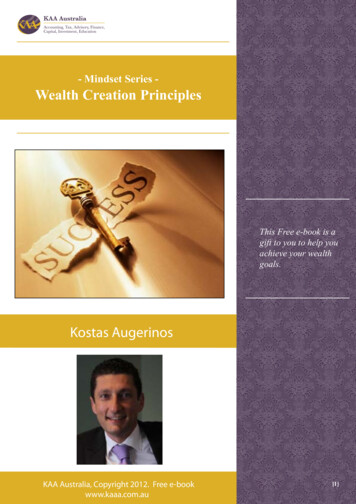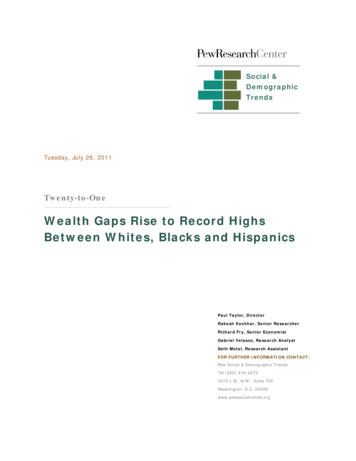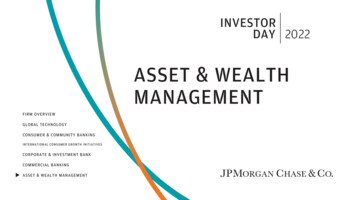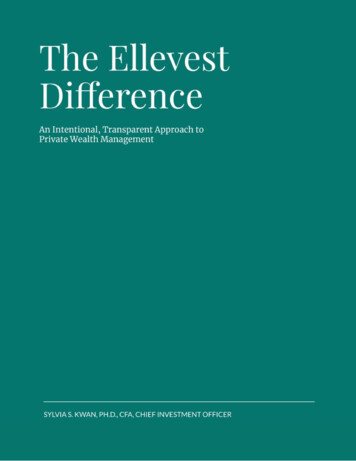
Transcription
THE ELLEVEST DIFFERENCE: PRIVATE WEALTH MANAGEMENT BY WOMEN, FOR WOMEN2We built Ellevest Private Wealth Management for investors who value an intentional,transparent approach to wealth management, and personalized solutions designed toachieve both investment and impact returns. As a fiduciary, our investmentphilosophy is, above all, client-centered and collaborative.First and foremost, we listen. We want to discover and understand your financialgoals, your liquidity needs, your risk capacity, your time horizon, the impact you wantyour money to have, and other considerations that are unique and important to you.Then we use that understanding toinvest your assets with intention bycreating globally diversified,cost-aware investment strategies withrisk and return characteristics built tohelp you achieve your financial goals.Our private wealth practice wasfounded on the belief that clients caninvest to achieve b oth financial andsocial returns, and we are excited toshare with you what we do.Our Investment MethodologyOur approach for building a strategic asset allocation and selecting investments isbased on modern portfolio theory,1 internal and third-party research, and bestpractices — like diversification, risk management, cost control, and tax minimization— that have historically led to successful investing outcomes over the long term. Wedon’t spend time or energy on activities that have been shown to yield mediocre orpoor results, such as predicting or timing the direction of the markets or pursuingtactical strategies (ie, making short-term bets).2We believe that clients’ portfolios should be well diversified across global equities,global bonds, and alternatives carefully selected for their potential to increase returnsand lower overall portfolio risk. This diversification strategy is designed to generateP ioneered by Harry Markowitz (Nobel prize winning economist), modern portfolio theory is a framework forcombining different asset classes to maximize return for a given level of risk.2h ttps://nyti.ms/2romClx1
THE ELLEVEST DIFFERENCE: PRIVATE WEALTH MANAGEMENT BY WOMEN, FOR WOMEN3differentiated sources of returns that have the potential to perform under varyingeconomic conditions.For security selection, we combine apassive approach that seeks marketreturns at low cost with an activeapproach that pursues above-marketreturns through the selection of p ublicinvestments and private alternatives .We select public investments withcharacteristics that research hasshown to positively a ffect long-termperformance historically. We chooseprivate alternatives with unique anddifferentiated strategies, strongperformance records, and lowcorrelation3 to public markets.We believe that one of our key strengths is our sourcing, diligence, research, andintentional selection of investments, particularly those with positive social impact.Research has shown that investments with high standards for environmental, social,and governance (ESG) and gender diversity have historically had the kind of positiveaffect on performance that we seek. We therefore choose to spend our research effortsdiscovering unique investment strategies that align with this philosophy. Theseinvestments are managed by seasoned managers with strong track records ofexecution and performance.We believe that the investments we offer on our platform have the potential to notonly enhance portfolio returns, but also to provide the positive and intentional impactour clients seek.Global EquitiesThe primary role of global equities in a diversified portfolio is to provide long-termgrowth and capital appreciation. In collaboration with Morningstar InvestmentManagement, LLC, a global investment research firm, we develop proprietaryC orrelation is a statistic that measures the degree to which two variables move in relation to each other. Twovariables that move in sync have a high correlation, and two variables that move differently from one another have lowcorrelation.3
THE ELLEVEST DIFFERENCE: PRIVATE WEALTH MANAGEMENT BY WOMEN, FOR WOMEN4strategic asset allocations based on forward-looking capital market assumptions, aswell as historical and current market conditions and asset class returns.At a high level, our current strategic asset allocations tend to favor value over growthstocks and US stocks over international, compared with global market capitalizations.Our capital market assumptions and strategic asset allocations are updated at leastannually and are subject to change as market conditions and the relative values ofasset classes change.Research shows that a passive, low-cost investing approach for global equities hashistorically outperformed market timing investment strategies and active stockselection based on analyses that predict how specific companies or industries mayperform in the future.4 B ut there is growing research showing that companies withmore diverse teams and practices that meet higher governance and environmentalstandards have historically achieved superior financial performance relative to peers.5We therefore believe that actively integrating diversity, governance, andenvironmental criteria into the investment selection process — while mindfullytracking close to a market benchmark — can reduce risk without sacrificing returns.While much of this research is new, we believe it’s clear that the potentialoutperformance and risk mitigation generated by these characteristics are real andsustainable in the long term. So we intentionally select both mutual funds andexchange-traded funds (ETFs) — and, where suitable, individual securities — thatdemonstrate the superior sustainability characteristics that, according to thisresearch, lead to higher financial performance relative to peers.6In short, rather than pursuing higher returns (usually with accompanying higher risk)through traditional active management methods and trying to predict marketbehavior, we seek higher returns — and lower risk — by focusing on governance andsustainability factors that history has shown to generate better financial results.Ellevest Intentional Impact PortfoliosEllevest Intentional Impact Portfolios are customized portfolios of individual US andinternational securities designed to track closely to a benchmark but outperform on4h ttps://bit.ly/2sAUTOK“How a Diverse Workforce Can Help Performance.” Barron’s. January 7, 2019; https://bit.ly/36edmPH ;https://mck.co/2sQE56s ; https://bit.ly/2RwEUM2 .6“Good for the Planet, Good for Stocks.” Barron’s. August 19, 2019.5
THE ELLEVEST DIFFERENCE: PRIVATE WEALTH MANAGEMENT BY WOMEN, FOR WOMEN5gender inclusion; diversity, governance, and environmental standards; and othersustainability factors.The Ellevest Intentional Impact strategy was specifically constructed to invest inindividual companies that perform better than their peers in areas that advance andbenefit women, and to give our clients the option to screen out companies withproducts, policies, and practices that may harm women. The focus areas we use todetermine whether an investment is appropriate for Ellevest Intentional ImpactPortfolios include not only leadership and equal pay, but also other factors that impactwomen disproportionately, as shown in the table below.77Focus es with poor diversity practices perpetuateexisting inequalities, create negative communityimpacts, and face substantial reputational risk.- Women in theWorkforce- Diversity Policies andPracticesFirearmsCompanies that produce and sell firearms enableviolence and face high reputational and regulatoryrisk. Guns exacerbate the harms of domesticviolence.- Firearm Production- Firearm Retail- Military and LawEnforcement- Overall FirearmInvolvementLabor RelationsCompanies with poor labor relations practices failto adequately engage with their workforce and facerisks from low worker retention, labor unrest, andwork stoppages. Labor rights are especiallyimportant for historically disadvantaged groups,including women.- Labor Unrest- Human CapitalDevelopmentHuman Rightsand CommunityCompanies that operate in countries withcontroversial regimes, or that restrict access tobasic services, share responsibility for humanrights infringements and other negativecommunity impacts. Companies that rely on forcedlabor are incentivized against humane laborreforms. The majority of workers affected by forcedlabor globally are women.- Controversial Regimes- Access to Basic Services- Employee HumanRights- Community Relations- Overall Human RightsProduct Qualityand SafetyCompanies with product safety concerns may be atrisk of harming consumers, incurring fines, orlosing market confidence. Women are vulnerable todata security issues in particular due to risks ofharassment.- Product and ServiceFailures- Data Privacy andSecurity RiskPlease see the disclosures section of this paper for research supporting the claims made in the description of eachfocus area.
THE ELLEVEST DIFFERENCE: PRIVATE WEALTH MANAGEMENT BY WOMEN, FOR WOMEN6WarCompanies that produce landmines, cluster bombs,or other controversial weapons havedisproportionately negative impacts on civiliannon-combatants, including women and children.- Landmines- Cluster Bombs- Other ControversialWeapons- Overall MilitaryWeaponsExploitativeProductsCompanies that rely on exploitative products andservices like tobacco or predatory loans profit fromaddiction and face substantial regulatory risks.Women make up a disproportionate share ofpayday lending customers.- Tobacco- Predatory LendingWorkingConditionsCompanies with poor working conditions put theirworkers in physical jeopardy and face high risk ofproductivity loss, labor disputes, and regulatorypenalties.- Occupational SafetyRisk- Human CapitalDevelopmentWater SourceImpactsCompanies that produce water pollutants mayharm ecosystems and yield negative health effectsfor humans and animals. Water pollutants can haveespecially harmful effects on pregnant women andtheir children.- Accidental Spills- Other Water PollutionEmissionsEthics andFraudCompanies with poor accounting practices,internal controls, and ethics records are at higherrisk of governance-related regulatory fines andpenalties. Wage theft is a form of accounting fraudperpetrated disproportionately againstdisadvantaged groups.- Accounting and AuditConcerns- Overall Business EthicsHazardousWasteCompanies that inadequately manage theirhazardous waste may have negative health andenvironmental impacts on the communities theyserve. Certain kinds of hazardous waste, such aswaste containing lead or other heavy metals, canhave especially harmful effects on pregnantwomen and their children.- Hazardous WasteEmissionsGreenhouse GasEmissionsCompanies that emit substantial volumes ofgreenhouse gases, either through combustion offuels in company operations or through purchasedelectricity, contribute to climate change and otherecosystem impacts. Climate change is expected tohave disproportionately negative impacts onwomen in the world’s poorest regions.- Carbon Emissions- Overall Greenhouse GasResearch has shown that companies with poor business practices in the above areastend to have higher risks that can adversely impact long-term financial performance.In contrast, intentionally investing in those companies with higher standards in
THE ELLEVEST DIFFERENCE: PRIVATE WEALTH MANAGEMENT BY WOMEN, FOR WOMEN7gender diversity and inclusion, and in environmental, social, and governancepractices, can lower risk and enhance returns over the long term.For clients with other or more specific impact goals, we can also design a customizedintentional impact strategy to match their personal values.Global DebtThe primary purpose of fixed income in a diversified portfolio is to preserve capitaland generate yield and income. For most private wealth clients, we design a US bondportfolio using individual investment-grade municipal bonds (typically those issuedin a client’s tax state, if appropriate). Municipal bonds help minimize current taxliabilities by generating tax-exempt income. Historically, they have also had a verylow correlation with global equities, so they help to diversify the overall portfolio.We design custom municipal bond portfolios for our clients in the form of b ond ladders— portfolios of individual bonds set to mature at regular intervals over a set timeperiod. Each year, as a portion (“rung”) of the ladder matures, that money can bereinvested to extend that time period.Bond Ladder Example
THE ELLEVEST DIFFERENCE: PRIVATE WEALTH MANAGEMENT BY WOMEN, FOR WOMEN8When building a municipal bond ladder, we consider a number of factors, includingthe current yield curve, the client’s tax state and tax posture, the liquidity andavailability of higher-quality municipal bond issuers in the client’s tax state and otherstates, the diversity of municipal issuers, and yields relative to municipals in otherstates and non-tax-exempt fixed-income investments. If high-quality inventory ofmunicipal bonds is limited within the client’s tax state, we seek to build a nationalmunicipal bond ladder, diversified across general obligation and revenue bonds.We do not make bets on the direction of interest rates — predictions from economistsand industry experts have rarely panned out.8 So rather than an active tradingstrategy, we manage these portfolios using a “buy and hold” approach, monitoring,rebalancing, and reinvesting income across the portfolio as needed. Each bondportfolio is designed to meet our client’s liquidity needs, tax posture, and quality andduration criteria.While there are many municipal bond mutual funds and ETFs (even some that arestate-specific), we believe that constructing individualized bond portfolios for ourclients has advantages over investing in funds and ETFs. First of all, with a custombond ladder, our clients will not be beholden to the aggregate behavior of a fund’sother shareholders, who may not be buy-and-hold investors. For example, ifinvestors fear higher interest rates, they may rush to redeem their shares in a bondfund. This would cause the fund manager to sell holdings at distressed prices, whichcan harm the remaining investors in the fund. In fact, owning individual bondpositions helps to mitigate interest rate risk, as long as each position is held tomaturity — while bond prices will rise and fall, clients can simply disregard thesefluctuations as they wait for maturity, at which time they can expect to receive theirprincipal back, as well as interest along the way. A personalized bond portfolio alsoallows clients to better control for factors such as liquidity needs and taxconsequences.To help enhance and add diversity to our clients’ fixed-income allocation, we mayalso add small allocations to bond sub-asset classes, such as high-yield municipalbonds and international bonds, through low-cost ETFs or mutual funds.8h ttps://cnb.cx/2sQHtOI
THE ELLEVEST DIFFERENCE: PRIVATE WEALTH MANAGEMENT BY WOMEN, FOR WOMEN9AlternativesAlternatives (investments that are neither stocks or bonds) can play an important rolein portfolios that have long-term horizons. Including different types of alternatives— such as direct real estate, private debt, and renewable energy assets — in aninvestment strategy has the potential to lower the overall risk of a portfolio, enhanceinvestment returns, and generate income.We seek private alternative investments that offer lowcorrelation with equities and bonds, competitive financialreturns, and a positive social and gender impact. Wegenerally pass on alternatives that lack thesecharacteristics, such as hedge funds, cryptocurrencies,late-stage private equity, managed futures, and macro,long-short, and derivative-based funds.We spend much of our investment research time andeffort sourcing, diligencing, and monitoring suitablealternative investments. We carefully research eachinvestment’s strategy, risk and return characteristics,potential for competitive returns, and correlation (or not)with equities and bonds. Any investment — regardless of its impact — must meet ourfiduciary standards and investment criteria. Only then do we consider its impact.Most of the alternatives we include in client portfolios are illiquid (ie, they cannot bebought or sold on a public securities exchange or secondary market like stocks andbonds) and only appropriate for investors with long investment horizons. And whileour alternatives are selected for their differentiated return characteristics, they alsohave idiosyncratic risk factors that are specific to the investment strategy.In our research and selection, we specifically focus on: Strategy : A differentiated investment strategy with sustainable competitiveadvantages that are implemented u sing a disciplined, repeatable investmentprocess. The strategy should also demonstrate low correlation between assetclasses in the portfolio to reduce overall portfolio risk.Performance : A strong track record of investment performance , d isciplinedexecution against strategy, and active risk mitigation process.
THE ELLEVEST DIFFERENCE: PRIVATE WEALTH MANAGEMENT BY WOMEN, FOR WOMEN 10Experience : A high degree of specialization and expertise, transparency in boththeir investment process and investor communications, and demonstratedalignment with investors’ interests.One example of an alternative we often include in client portfolios is private debt.There are unique opportunities within the private global debt markets for investorswho have the capacity for illiquidity to earn enhanced yields relative to the debt (ie,fixed income) securities offered in public, liquid markets. Trade finance andgrowth-stage loans to profitable small- and medium-sized enterprises in emergingeconomies also offer investors a way to invest in emerging markets without thevolatility associated with emerging market equity. These loans also provide capitalcritical to growing firms in countries experiencing financial dislocation.These types of alternative investments — private debt in the US and emergingcountries — have unique risk and return characteristics that are different from publicequity and debt markets. Within a portfolio, they diversify overall risk while providingthe opportunity for enhanced yields and income. While these strategies are illiquid,the historically low default rates, high relative yields, and low correlations to both USequity and fixed income markets make them a compelling alternative investment inwell-diversified portfolios.Similarly, alternative investments in private real estate can add significant benefits toan investment portfolio. Examples of private real estate investing include investmentsin the development and preservation of affordable housing for very low- tolow-income residents, as well as investments in the acquisition and sustainablerenovation of multi-family workforce housing. Data shows that the supply ofaffordable multi-family housing for low- to middle-income residents has beenshrinking over the past 15 years, while demand continues to grow.9 The managers wework with and actively seek have long track records of successful execution,specialized expertise, and deep networks and relationships in their respective areas.Within the real estate sector, we believe that investments in affordable housingpositively impact low and middle income families, and have the ability to weatherperiods of market stress and recession better than other types of real estate due to thegrowing imbalance of housing supply and demand for low- and moderate-incometenants.9h ttps://bit.ly/2DWCqyM
THE ELLEVEST DIFFERENCE: PRIVATE WEALTH MANAGEMENT BY WOMEN, FOR WOMEN11Investing in renewable power projects — such as solar, wind, and hydro — may alsoadd diversification, hedge against inflation, enhance yield, and have a positiveenvironmental impact for a portfolio. According to Bloomberg New Energy Finance(2019), 50% of global electricity is expected to come from wind and solar by 2050.10Investment in renewable energy generation capacity (ie, renewable power plants) isexpected to total 10 trillion over the next 30 years, and global renewable capacity isexpected to grow by over 1 terawatt (eg, 1 trillion watts) — a 46% growth over theperiod of 2018 to 2023.11 This growth, coupled with the falling costs of renewablepower plant construction and solar equipment, creates investment opportunities withreturns that we believe are sustainable in the long-term regardless of the economic ormarket environment. Plus, an investment in this sector’s low correlation with publicmarkets, together with stable cash flows, can help lower the overall risk of a portfoliowhile enhancing returns.Because no one can predict what will happen in the future, we intentionally seekalternatives with characteristics that, in aggregate, have the potential to delivertargeted expected returns under different market environments, including periods ofstress. Many of the alternatives that meet this and our other investment criteria alsohave the kinds of social impact our clients seek.In most cases, the investment itself provides capital to benefit those who areeconomically challenged, whether it be affordable housing or small businesses thatwould otherwise be unable to access growth capital. But the impact doesn’t have tostop there. One of our private real estate managers also sets aside a number of units atsome of the properties for non-profits in the community to provide transitionalhousing to individuals and families who need housing assistance. The manager wework with to provide loans to businesses in emerging economies screens eachborrower using specific sustainability criteria. Each borrower also commits to specificsocial impact mandates, such as increasing the number of women employees, or moreefficient energy usage.Rebalancing and Tax EfficiencyOur client portfolios are intentionally designed to generate returns over the long termwith low portfolio turnover. We avoid short-term and reactive trading that researchshows is generally unproductive and potentially harmful to long-term returns.1210h ttps://about.bnef.com/new-energy-outlook/11I nternational Energy Agency, Renewables 2018, Market analysis and forecast from 2018-2023.12h ttps://bit.ly/33YoGhr
THE ELLEVEST DIFFERENCE: PRIVATE WEALTH MANAGEMENT BY WOMEN, FOR WOMEN12Instead, we monitor portfolio positions and overall asset allocation regularly, and werebalance within and across asset classes as needed.Cash flows in excess of the client’s income requirements will be reinvested to helpmaintain the overall target asset allocation. Whether we decide to fully rebalance aportfolio will depend on multiple factors, such as market movements in publiclytraded investments, relative valuations across asset classes, unanticipated liquidityneeds, bond maturities and redemptions, private investment liquidity events, and newpublic and private investment opportunities.We pay careful attention to ongoing tax consequences by employing tax minimizationtechniques, such as tax-loss harvesting, strategic use of cash flows in rebalancing,and minimizing short-term gains when trading. We also carefully consider the taxefficiency and after-tax expected returns of each investment we select for our clients’portfolios, as well as the best placement of each type of investment across taxable andtax-advantaged accounts. We balance tax considerations with trading costs anddiversification benefits.Clients with significant unrealized capital gains may invest in Opportunity Zone (OZ)funds,13 which are designed to both defer taxes owed on those gains and provide theopportunity to earn tax-free returns in the long term. While OZ funds are relativelynew (created through the Tax Cut and Jobs Act of 2017 ), the strategies underlying theOZ funds we offer to our clients have robust track records. We s pecifically seek OZfunds offered by managers who have demonstrated strong execution in opportunityzones.The Financial Future Is DecidedlyFemaleMany of our private wealth clients are drawn to Ellevest because of our mission:helping women of all means and ages achieve financial success. We heard from ourclients that they felt understood by our f or women, by women f irm, and that investing13O pportunity Zone funds are investment funds created to encourage private investment in economicallydisadvantaged communities nationwide, called qualified opportunity zones. The Opportunity Zone Program, createdby the 2017 Tax Cuts and Jobs Act, p rovides tax benefits to investors who invest eligible capital in these zones throughOpportunity Zone funds.
THE ELLEVEST DIFFERENCE: PRIVATE WEALTH MANAGEMENT BY WOMEN, FOR WOMEN13in women was important to them. So we went to work, researching different gendergaps and how investing might help close those gaps.The result is Ellevest’s gender-lens investment strategy — investments designed togenerate financial return and advance and benefit women. This strategy focuses on: Public companies highly ranked for advancing and supporting women in theworkforcePublic companies whose policies and practices have been shown to help andbenefit womenInvestments that provide capital directly to women founders and businessesowned or run by women, through private equity or private debtBusinesses providing products and services that primarily benefit womenOrganizations that work to close social and economic gaps that directly andindirectly impact women.Gender-lens investing is still relatively new, and there aren’t very many options thatmeet all of our criteria. Instead of waiting for fund companies to catch up, we’vereached out to managers who have strong investment strategies to advocate forinvestments that meet our impact and gender-lens criteria. And we’re speaking withmanagers who have an interest in developing investments that meet our fiduciary a ndimpact lens criteria. This has been met enthusiastically — and today, we’re working toincorporate more gender lenses into our existing investment process to create newsolutions that our clients demand.Intentionally considering gender when investing is not just about advancing women(which has been shown to benefit families and communities as well14); it’s also aboutthe opportunity to achieve stronger returns— seeking that gender factor in ourinvestments’ performance.The research shows that women borrowers pay back loans at a higher rate than mendo, yet find it more challenging to get loans (which also end up being smaller).15Providing loans to women-owned businesses not only helps close this gender fundinggap, but is also a smarter investment that carries less risk than providing loans to onlymen-owned businesses.14h 16/07/minority women entrepreneurs building skills barr.pdf15
THE ELLEVEST DIFFERENCE: PRIVATE WEALTH MANAGEMENT BY WOMEN, FOR WOMEN14The trend is clear: Women are taking a larger role in driving the economy. Since 1979,women’s gains account for most of the rise in real US household income.16 Today,there are more women entering college, more women gaining undergraduate andadvanced degrees, more women in the workforce, and more women makinghousehold financial decisions than men.17 Research shows that companies withmore diverse leadership teams have superior financial performance compared to theirpeers.18Investment professionals are always looking for that edge — combing through thedata to determine what factors and characteristics will lead to superior investmentperformance. We are no different, although the factors we focus on are. Ourinvestment strategies are based on the data and research that has shown to lead tosuccessful investment outcomes historically, and we avoid practices that studies showare harmful to long-term performance.It’s the holy grail when there’s an opportunity for both successful investing andbenefiting others by closing gender gaps. The research and data is there — andgrowing. At Ellevest, our intentional pursuit of both financial returns together withthe impact that we believe will help drive those returns is an opportunity for ourclients to do well and good, both for themselves and others.16h ttps://bit.ly/2sVOT3nh ttps://on.wsj.com/2qxeZsH ; “Financial Literacy Has a Gender Gap.” Wall Street Journal, print. Sept 3, 2019;“Women's Clout in Spending Grows.” Wall Street Journal, print. Sept 9, 2019.18“How a Diverse Workforce Can Help Performance.” Barron’s. January 7, 2019.17
THE ELLEVEST DIFFERENCE: PRIVATE WEALTH MANAGEMENT BY WOMEN, FOR WOMEN15DisclosuresThis whitepaper was last updated in December 2019. 2019 Ellevest, Inc. All rights reserved.The statements contained herein are the opinions of Ellevest. All opinions and views constituteour judgments as of the date of writing and are subject to change at any time without notice.Research supporting the descriptions for each focus area of Ellevest Intentional ImpactPortfolios: Workplace Diversity, https://bit.ly/2HG8jyl ; Firearms, https://every.tw/2K0e2Sr ;Labor Relations, h ttps://bit.ly/1VlFPeM ; Human Rights and Community,https://bit.ly/2QR1xYL ; Product Quality and Safety — data privacy, https://bit.ly/2B6DKNK ,product failures, https://bit.ly/2twVa2s ; War, h ttps://bit.ly/2QuohRd ; Exploitative Products —tobacco, https://bit.ly/2OSgon9, predatory lending, https://bit.ly/2ka70hT ; WorkingConditions, https://bit.ly/2ka70hT ; Water Source Impacts, https://bit.ly/2q7ffOv ; Ethics andFraud — wage theft, https://bit.ly/35reQqg, fraud, https://bit.ly/2J4wS8n ; Hazardous Waste,https://bit.ly/35xsVma ; Greenhouse Gas Emissions, h ttps://bit.ly/2rvSKDh .Ellevest Intentional Impact Portfolios are separately managed equity accounts that aresub-advised by Ethic, Inc., an SEC-registered investment advisor . As sub-advisor, Ethicconstructs and manages portfolios of individual stock positions be
THE ELLEVEST DIFFERENCE: PRIVATE WEALTH MANAGEMENT BY WOMEN, FOR WOMEN 4 strategic asset allocations based on forward-looking capital market assumptions, as well as historical and current market conditions and asset class returns. At a high level, our current strategic asset allocations tend to favor value over growth



